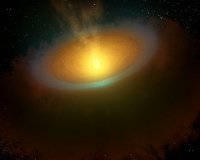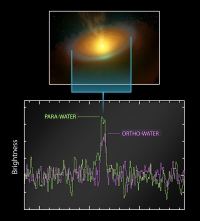Herschel discovers tip of cosmic iceberg around nearby young star
20 October 2011
Using ESA's Herschel Space Observatory to study one of the closest protoplanetary discs to Earth, astronomers have detected cold water vapour for the first time in such an environment. Located in a thin layer at intermediate depths in the disc, the cold vapour hints at a much larger reservoir of water ice hidden deeper in the disc and amounting to several thousand times the mass of water that makes up our planet's oceans. The discovery sheds new light on the presence and role of water in the early formation stages of a planetary system. |
|
Artist's impression of the protoplanetary disc around the young star TW Hydrae. |
The formation of stars through gravitational collapse of molecular clouds is always accompanied by the emergence of a disc that rotates around the central protostar and funnels material from the cloud onto it. Although mostly composed of gas, these discs also contain small amounts of cosmic dust – a moderate but nevertheless important contribution since dust represents the raw material from which planets like our own eventually take shape.
The role of water in this context is crucial. By tying up most of the oxygen present in the disc, water dominates the chemical evolution of several other species, both in gaseous and solid state, and is thus a powerful diagnostic of the disc's chemical and physical structure. Moreover, in the cold regions of the disc where it is mostly found as ice, water facilitates the agglomeration of dust grains into increasingly larger aggregates which subsequently evolve into solid bodies such as asteroids, comets and planetesimals, the seeds of future planets.
Confined in small, icy bodies at large distances from the central star, beyond the so-called snow line, water and other molecules from the primordial cloud are preserved and survive throughout the system's evolution. At later stages, the migration of comets and asteroids may act as efficient carriers bringing a variety of molecules to already formed planets; such a mechanism is believed to have delivered water on Earth. Studying the distribution of water across protoplanetary discs thus provides crucial insight into some currently poorly understood processes that lead to the formation of a planetary system.
"We are particularly interested in understanding where in a disc, and under which conditions, water freezes out and subsequently evaporates back into the gas," explains Michiel Hogerheijde from the University of Leiden, in the Netherlands. Hogerheijde led an international team that used Herschel to search for evidence of water in the disc surrounding TW Hydrae, a young and nearby T Tauri star. "Previous studies of similar objects have detected either hot water vapour from the inner part of discs or, in only a few cases, water ice from the outskirts of discs. Our observations demonstrate the presence of cold water vapour across the disc," he adds. The results of Hogerheijde and his collaborators are published in the 21 October issue of the journal Science.
 |
|
Detection of water vapour in the spectrum of TW Hydrae's protoplanetary disc. |
The water vapour detected using the HIFI spectrometer on Herschel corresponds to temperatures lower than 100 K, in contrast to the hot vapour – with temperatures above 250 K – that was previously detected in the vicinity of other young stars. This new detection required about 18 hours of observations, one of the longest integrations performed with HIFI. The excellent spectral resolution of HIFI allowed the astronomers to pinpoint where in the disc the cold vapour is located; it is clear that it is distributed across the entire extent of the disc.
"Our modelling of the data suggests that the cold vapour we detect is confined to a thin layer at an intermediate depth in the disc, where the evaporation and freeze-out processes find a balance," notes Ewine van Dishoeck, also from the University of Leiden. Van Dishoeck is the Principal Investigator of the Water In Star-forming regions with Herschel (WISH) Key Programme of which this study is a part. The cold vapour production is triggered by the flux of ultraviolet and X-ray photons from the central star, and possibly from other neighbouring stars. "These highly energetic photons are capable of travelling through the outer regions of the disc, penetrating up to a certain depth. There, they encounter water molecules that had previously frozen out onto dust grains and break them apart, liberating hydrogen and oxygen atoms as well as intact water molecules," she adds.
This reaction, known as photo-desorption, releases water back into the gas phase, where it can be detected as vapour by HIFI. Thus, the cold vapour observed by Hogerheijde's team represents, quite literally, the tip of a much larger iceberg, as it hints at a copious and otherwise undetectable supply of water ice hidden in the disc's deeper and colder layers.
"The signal we detected accounts for an amount of water, in cold vapour, corresponding to about 0.5 per cent of the mass of water held in the Earth's oceans," comments Hogerheijde. "In order to produce this quantity of vapour, however, an enormous reservoir of water ice must be lurking in this protoplanetary disc, equivalent to several thousand times the mass of water covering our planet's surface," he adds.
By using the cold vapour signature to trace the total water content in the disc, this study demonstrates for the first time that a protoplanetary disc can harbour such large amounts of water ice. Further observations with Herschel of more distant discs are planned in order to probe whether other nascent planetary systems are similarly rich in water.
"Only Herschel is able to follow the trail of water through all the steps of star and planet formation," comments Göran Pilbratt, Herschel Project Scientist at ESA. "By probing water in a protoplanetary disc, these observations are of great importance to our understanding of how planetary systems such as our own Solar System are born and evolve."
Notes for editors
The study described here is based on observations performed with Herschel's Heterodyne Instrument for the Far Infrared, HIFI. The observations were carried out as part of the Water In Star-forming regions with Herschel (WISH) Key Programme which was designed to probe the water abundance across the entire stellar and planetary formation process, from collapsing clouds to young stellar objects and planet-forming discs.
This study focussed on the protoplanetary disc surrounding TW Hydrae, a 10-million year old T Tauri star with a mass of 0.6 times the Sun's mass. Located about 175 light-years away, TW Hydrae's disc is one of the closest to Earth and thus one of the best studied among protoplanetary discs.
Herschel is ESA's infrared space observatory with science instruments provided by European-led Principal Investigator consortia and important participation from NASA.
HIFI, or the Heterodyne Instrument for the Far Infrared, has been designed and built by a consortium of institutes and university departments across Europe, Canada, and the United States under the leadership of SRON Netherlands Institute for Space Research, Groningen, the Netherlands, with major contributions from Germany, France, and the US.
HIFI Consortium members are: Canada: CSA, U. Waterloo; France: CESR, LAB, LERMA, IRAM; Germany: KOSMA, MPIfR, MPS; Ireland: NUI Maynooth; Italy: ASI, IFSI-INAF, Osservatorio Astrofisico di Arcetri-INAF; Netherlands: SRON, TUD; Poland: CAMK, CBK; Spain: Observatorio Astronómico Nacional (IGN), Centro de Astrobiología (CSIC-INTA); Sweden: Chalmers University of Technology - MC2, RSS & GARD, Onsala Space Observatory, Swedish National Space Board, Stockholm University – Stockholm Observatory; Switzerland: ETH Zurich, FHNW; USA: Caltech, JPL, NHSC.
Related publications
M. Hogerheijde, et al., "Detection of the Water Reservoir in a Forming Planetary System", 2011, Science, Vol. 334 no. 6054 pp. 338-340. DOI: 10.1126/science.1208931
Contacts
Michiel Hogerheijde
Leiden Observatory
Leiden University, The Netherlands
Email: michiel strw.leidenuniv.nl
strw.leidenuniv.nl
Phone: +31-71-527-5590
Ewine van Dishoeck, Principal Investigator of the WISH Key Programme
Leiden Observatory
Leiden University, The Netherlands
and Max-Planck-Institut für extraterrestrische Physik (MPE)
Garching, Germany
Email: ewine strw.leidenuniv.nl
strw.leidenuniv.nl
Phone: +31-71-527-5814
Göran Pilbratt
Herschel Project Scientist
Research and Scientific Support Department
Science and Robotic Exploration Directorate
ESA, The Netherlands
Email: gpilbratt rssd.esa.int
rssd.esa.int
Phone: +31-71-565-3621


